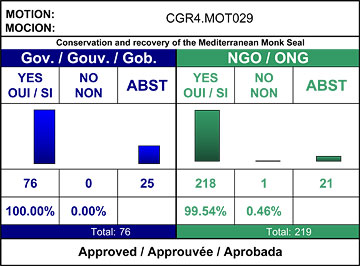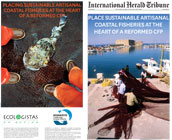Help us stay online

We have been publishing The Monachus Guardian since May 1998, and since that time have carried the news, views and perspectives of over 200 correspondents from 29 countries, with contributors ranging from fishermen to UN diplomats, historians to taxonomists, veterinarians to MPA managers.
If you would like to help us continue publishing, please consider making a donation through Paypal.
If you can’t manage that in these straitened times, we would still like to hear from you. If you have an opinion you would like to air on monk seal conservation generally, or on news items or articles published on this site in particular, please write to us at
. And remember, you can also post your comments in ‘real time’ (following the moderator’s OK), on the parallel TMG news blog.
IUCN let down
TMG has learnt that there has been “no” progress on any aspect of implementing the IUCN General Assembly Resolution on the Mediterranean monk seal, overwhelmingly endorsed by delegates at the World Conservation Congress, held in Barcelona in October 2008.

According to the official record, 100% of government delegates voted for the motion and 99.54% of NGOs. Despite those results, no tangible headway has apparently been made to meet its recommendations.
The resolution [4.023 Conservation and Recovery of the Mediterranean Monk Seal Monachus monachus, PDF  20KB], calls upon all Mediterranean countries to “maintain and increase their efforts to aid the recovery” of the species, emphasising the expansion of MPAs and an improvement in management. 20KB], calls upon all Mediterranean countries to “maintain and increase their efforts to aid the recovery” of the species, emphasising the expansion of MPAs and an improvement in management.
The resolution, however, also calls upon the IUCN Director General to: “Stimulate and facilitate collaborative Monk Seal conservation projects among IUCN’s Mediterranean members with the assistance of the Pinniped Specialist Group [PSG] of the Species Survival Commission.”
Despite the media hoopla surrounding the Barcelona event, it appears that no tangible movement has been made in achieving those aims.
A terse communication from PSG Chair Kit Kovacs, who had previously expressed some optimism that progress would be made in enacting the resolution, simply stated that there was “no news” to report.
According to some monk seal specialists, the IUCN PSG is hampered by an absence of contemporary expertise of Mediterranean monk seal issues, with no current conservation or field biology experience of Monachus monachus represented within the Group.
The PSG itself stated, in yet another report – the 2008 IUCN Reassessment of the Status of Monk Seals: ‘At this time prospects for the remaining members of the genus Monachus, a group of animals that has survived for more than 10 million years, are not good. Only about 1,500 individuals remain in two widely separated species, each of which faces numerous threats. Serious and effective conservation actions are needed if monk seals are to persist in the future.‘
Further information
IUCN. 2009. 4.023 Conservation and recovery of the Mediterranean monk seal Monachus monachus. Resolution, 4th IUCN World Conservation Congress, Barcelona, 5-14 October 2008: 1-2. [PDF  20KB] 20KB]
Lowry, L., D. Aurioles, V. Burkanov, C. Campagna, N. Gales, T. Gelatt, S. Goldsworthy, G.J. Hofmeyr, T. Härkönen, K.M. Kovacs, C. Southwell, D. Thompson, F. Trillmich and A. Aguilar (IUCN Pinniped Specialist Group). 2009. The 2008 IUCN reassessment of the status of monk seals. Poster presentation, in: Workshop “Research, Management, Conservation, and Policy in Monk Seal Recovery: A Global Perspective”, 18th Biennial Conference of the Society for Marine Mammalogy. 10th October 2009, Quebec, Canada. [PDF  295 KB] 295 KB]
Notes from Nagoya
Perspectives, hopes, resolutions – and, time will tell, broken resolutions – from the UN biodiversity convention meeting in Nagoya, Japan, October 2010:
Ahmed Djoghlaf, executive secretary of the UN Convention on Biological Diversity (CBD), described the meeting in Nagoya, Japan, as a "defining moment" in the history of mankind.
Referring to the target set at the UN World Summit in 2002, he said: "Let's have the courage to look in the eyes of our children and admit that we have failed, individually and collectively, to fulfil the Johannesburg promise made by 110 heads of state to substantially reduce the rate of loss of biodiversity by 2010.”
Ten years' to solve nature crisis, UN meeting hears, BBC News, 18 October 2010.
Over 15,000 participants representing the 193 Parties and their partners, the highest number ever recorded for such a meeting, will meet to finalize the negotiation on a new Strategic Plan on biodiversity for the period 2011-2020 with a biodiversity vision for 2050. The adoption of a new protocol on access and benefit sharing will be a key instrument at the service of this new biodiversity vision. The agreement will be submitted to the high-level segment of the Conference, to be held with the participation of five Heads of State and 130 ministers of the environment.
“In launching the International Year of Biodiversity the United Nations Secretary General stated earlier this year, that business as usual is no longer an option,” said Ahmed Djoghlaf, Executive Secretary of the Convention on Biological Diversity. “The time to act is now and the place to act is here at the Aichi-Nagoya Biodiversity Summit.”
Convention on Biological Diversity. 2010. The Aichi Nagoya Summit on Biodiversity: a new Biodiversity Strategy for the twenty-first century. Press release, Nagoya, Japan, 18 October 2010. [PDF  156 KB] 156 KB]
‘Shortly before the summit begins, I've finally got round to reading the draft declaration that will be discussed by the governments meeting at Nagoya in Japan. It's 195 pages long. If it were a thesis about the causes and consequences of the decline of the world's wild species, it would get a fairly high mark. As an action plan for doing something about this decline, it's a dead loss.
It begins by reminding us of the comprehensive failure of the last big declaration, in 2002. Then the governments agreed to "achieve by 2010 a significant reduction of the current rate of biodiversity loss". The new declaration begins by saying this hasn't been met "in full". Later, it concedes that it hasn't been met at all […]
The declaration also suggests a fairly reasonable list of what should, in principle, be done to defend biodiversity. It proposes 20 targets, which include recognising the value of biodiversity in national planning, getting rid of incentives to destroy it, switching to sustainable farming and forestry, protecting coral reefs from climate change, creating more protected areas, giving special help to threatened species and eradicating invasive species. There's only one problem: the governments agreeing to these measures don't actually have to do anything.
All these targets, virtuous as they are, are merely "aspirations for achievement at the global level" and a "flexible framework" within which countries decide what they want to do. The governments signing up to them are "invited" to set their own targets, and only for those measures they deign to adopt. There are no sanctions and no specific measures to which particular governments must agree.
Any text which might imply acting on these proposals, even voluntarily, is in square brackets – meaning that it has been contested and might not be adopted. This includes the following, at the beginning of the list of targets:
"Take effective and urgent action towards halting the loss of biodiversity"
What are the prospects for the Nagoya biodiversity summit? by George Monbiot, The Guardian,18 October 2010
Monachus Guardian news blog

The Monachus Guardian news blog continues to deliver breaking news updates between the summer and winter issues of the journal.
If you have monk seal-related news, images or video you would like to submit for publication, please contact the
.
Publications Watch
We take the opportunity of alerting our readers to the following publications, on marine biodiversity or broader conservation issues.

Ocean 2012 / nef. 2010. Fish dependence. The increasing reliance of the EU on fish from elsewhere: 1-32. [PDF  1MB] 1MB]
“Fish Dependence: The increasing reliance of the EU on fish from elsewhere, shows the extent to which Europeans are importing fish by exporting overfishing. Fish stocks are a renewable resource. According to latest figures from the European Commission, 72 per cent of assessed fish stocks in European waters are overfished.”

Ecologistas en Acción / Ocean 2012. 2010. Placing sustainable artisanal coastal fisheries at the heart of a reformed CFP: 1-2. [PDF  729 KB] 729 KB]
Common statement by artisanal coastal fishers, international and European NGOs on the necessity of reforming the EU Common Fisheries Policy.
“Our organisations of artisanal coastal fishers and NGOs share a common interest in placing European fisheries on a sustainable footing by supporting the reform of the Common Fisheries Policy (CFP) in ways which ensure the recovery of fish stocks and marine habitats where necessary; the promotion of sustainable fisheries; a just allocation of fishing access based on social and environmental criteria; and an equitable distribution of the benefits derived from these activities.”
EndQuote
Lobster is, of course, the current prize catch in the Bahamas, but in earlier times other species were even more valuable. These fisheries were either totally destroyed – like the monk seal – or reduced to non-commercial levels – like the marine sponge – by over-exploitation.
Most Bahamians are probably unaware that seals once thrived in our waters. In 1707, for example, a traveller reported that “sometimes fishers will catch a hundred in a night.” Each animal produced about 20 gallons of oil, which was exported to plantations in the West Indies to lubricate cotton mills. But by the end of the 19th century, the seal population had been hunted to extinction.
Source: The Past, Present & Future of Bahamian Fisheries, by Larry Smith, Bahama Pundit.
|
|





